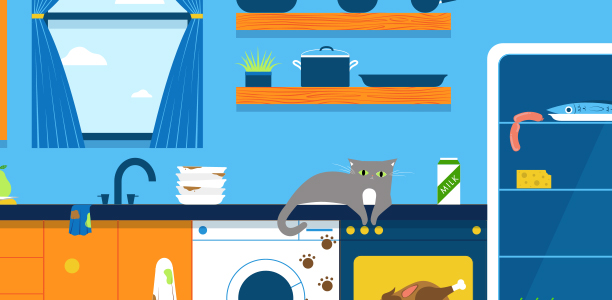Learning and discussing food safety hazards in a kitchen
Crazy Kitchen
Learning and discussing food safety hazards in a kitchen

- HWB 0-15a - I am developing my understanding of the human body and can use this knowledge to maintain and improve my wellbeing and health.
- HWB 0-16a
- HWB 0-33a
- HWB 1-15a - I am developing my understanding of the human body and can use this knowledge to maintain and improve my wellbeing and health.
- HWB 1-16a
- HWB 1-33a - I am becoming aware of how cleanliness, hygiene and safety can affect health and wellbeing and I apply this knowledge in my everyday routines such as taking care of my teeth.
- identify kitchen hazards
- demonstrate understanding of ways to prevent kitchen hazards
Advice for parents and carers
- open the Crazy Kitchen interactive
- discuss what’s wrong with the kitchen and find the food safety hazards (they can be found in the Activities section)
- open the Kitchen pledge and encourage ideas to write on it
- display the Pledge in your kitchen as a reminder
- choose other activities below in the Activities section
Activities
- display the interactive kitchen scene on the whiteboard and, working together as a class, ask pupils, 'What is wrong in this kitchen?'
- allow pupils to come up to the front and click on the areas on the interactive kitchen where pupils think there is a food safety issue
- ask/discuss 'What's wrong here?' for each problem the pupils identify and agree if it is a problem or not (for 'yes' a warning sign comes up and stays)
- the hazards are:
- high fridge temperature
- pink chicken in the oven
- milk out of the fridge
- fish is on the top shelf of the fridge
- sausages are not in a sealed container and are on the top shelf
- peppers are not in the vegetable drawer
- milk is not in the fridge
- fridge door is open
- cat is on worktop with dirty paws
- dirty plates left on worktop
- dirty tea towel and dish cloth
- fruit and meat are being cut on same chopping board
- the number and type of hazards identified in the lesson can be tailored to the age and level of the pupils by the teacher as it is an open ended activity
- allow pupils to look carefully at the interactive scene with the warning signs for up to a minute, trying to remember the different problems
- when the minute is up, click 'I'm done' and 'start again' to remove the answers from the whiteboard
- pupils take turns to name a problem on the scene again
- keep going until all the hazards have been remembered – some prompting may be needed towards the end
- display the interactive scene again and ask pupils to think about their own kitchens
- what can they do to help stop potential food safety hazards in their kitchen?
- Encourage ideas such as 'I can help keep the fridge cold by making sure the door is closed and temperature is below 5 degrees C', 'I can help to put food back in the fridge so that it doesn't go off', or 'I can make sure my pets don’t walk on the worktops', 'I can make sure that my chicken is cooked all the way through by checking there is no pink meat and the juices run clear'.
- pupils fill out 'Kitchen Pledge' to take home – either individually or as a whole class
Assessment opportunities
DO – Can pupils find food safety hazards on the interactive kitchen scene?
SAY – Can pupils tell what might happen because of the hazard?
Consider CfE Benchmarks, for example:
- demonstrates an understanding of basic food hygiene and safety through, for example, washing fruit and vegetables, storing perishables in the fridge
Cross-curricular links
Literacy and English – listening and talking
Differentiation
Support
Pupils can tell an adult their pledge, which can then be scribed onto the pledge page or copied by the pupil.
Challenge
Research more about why the hazards are food safety issues and what can happen.
